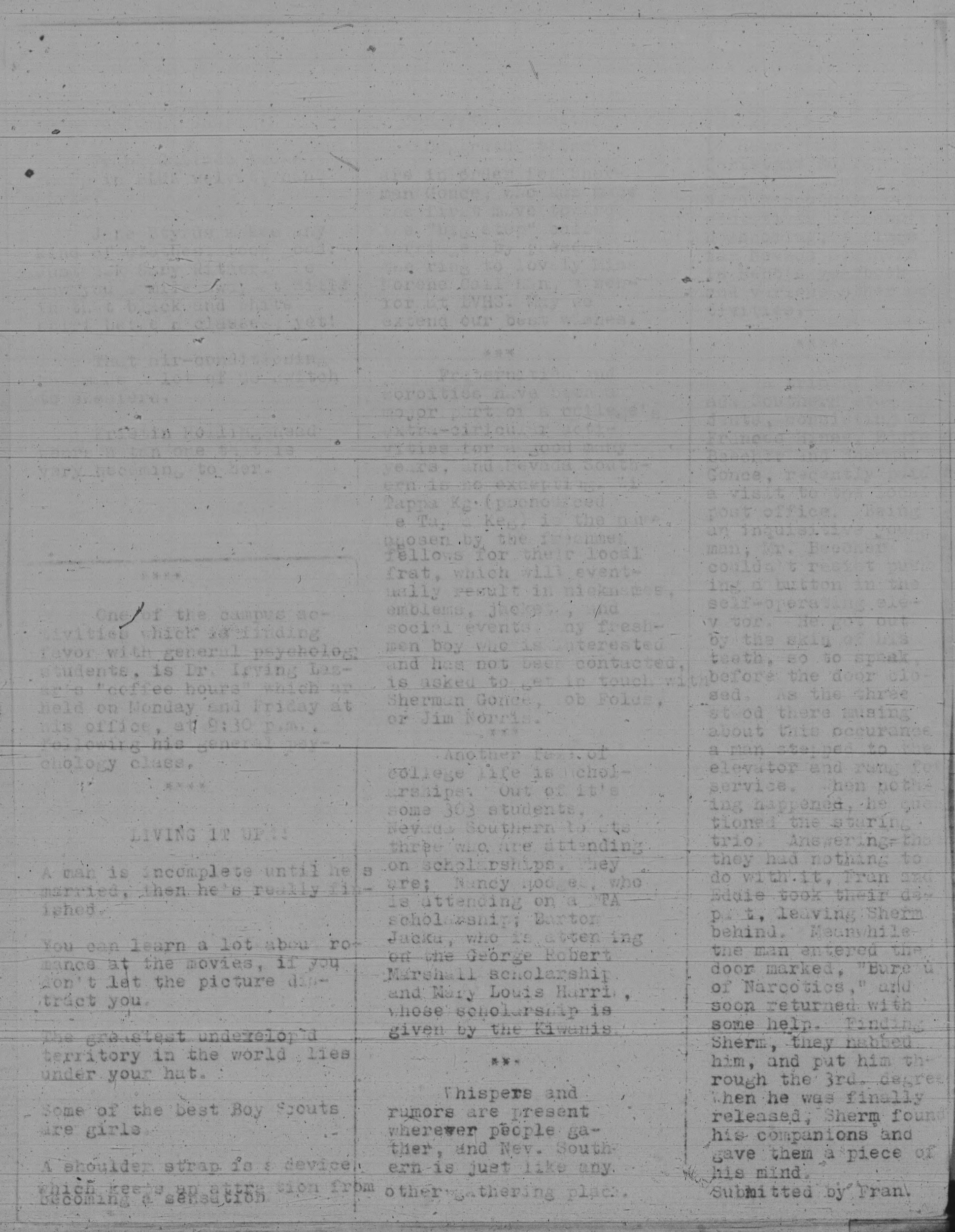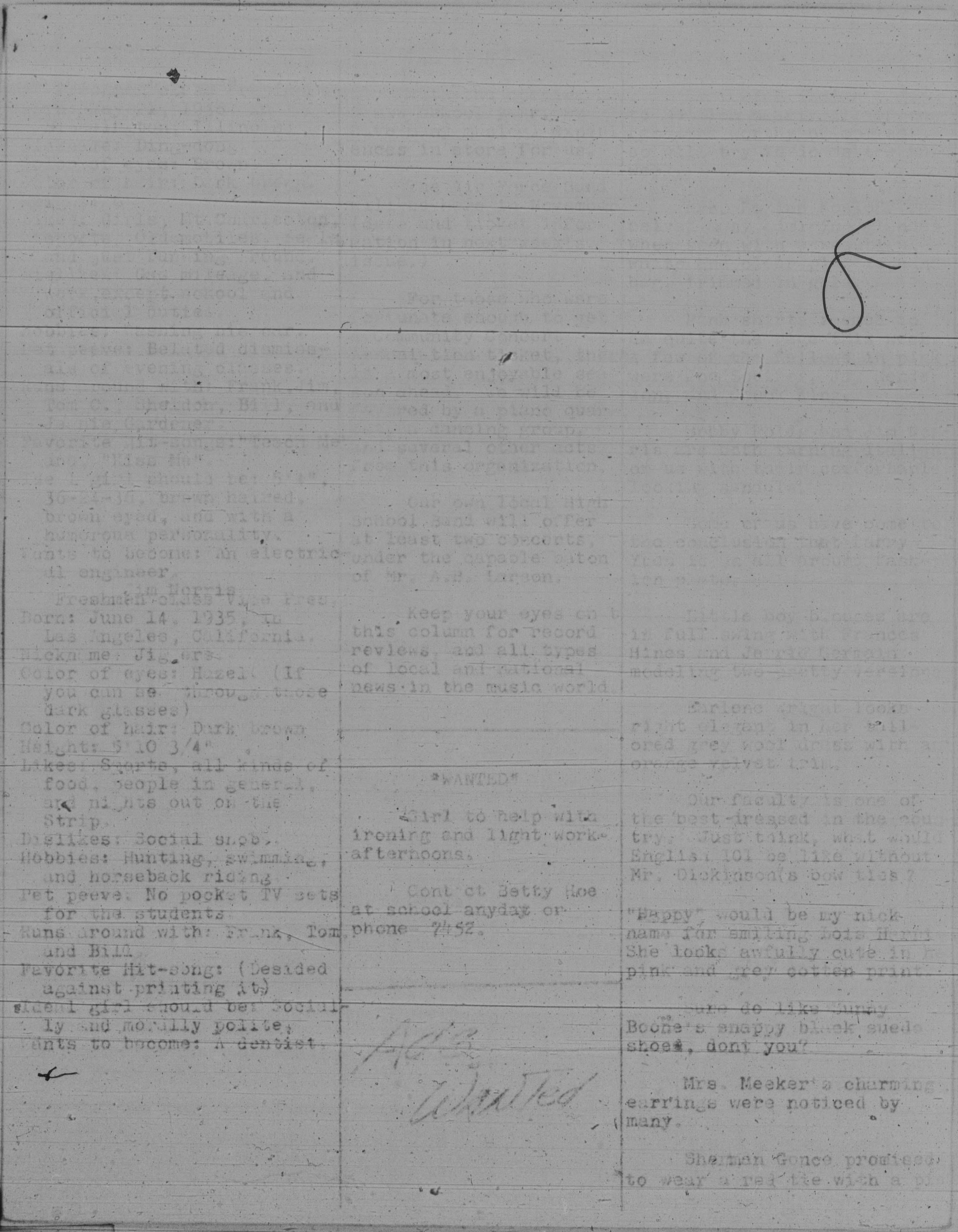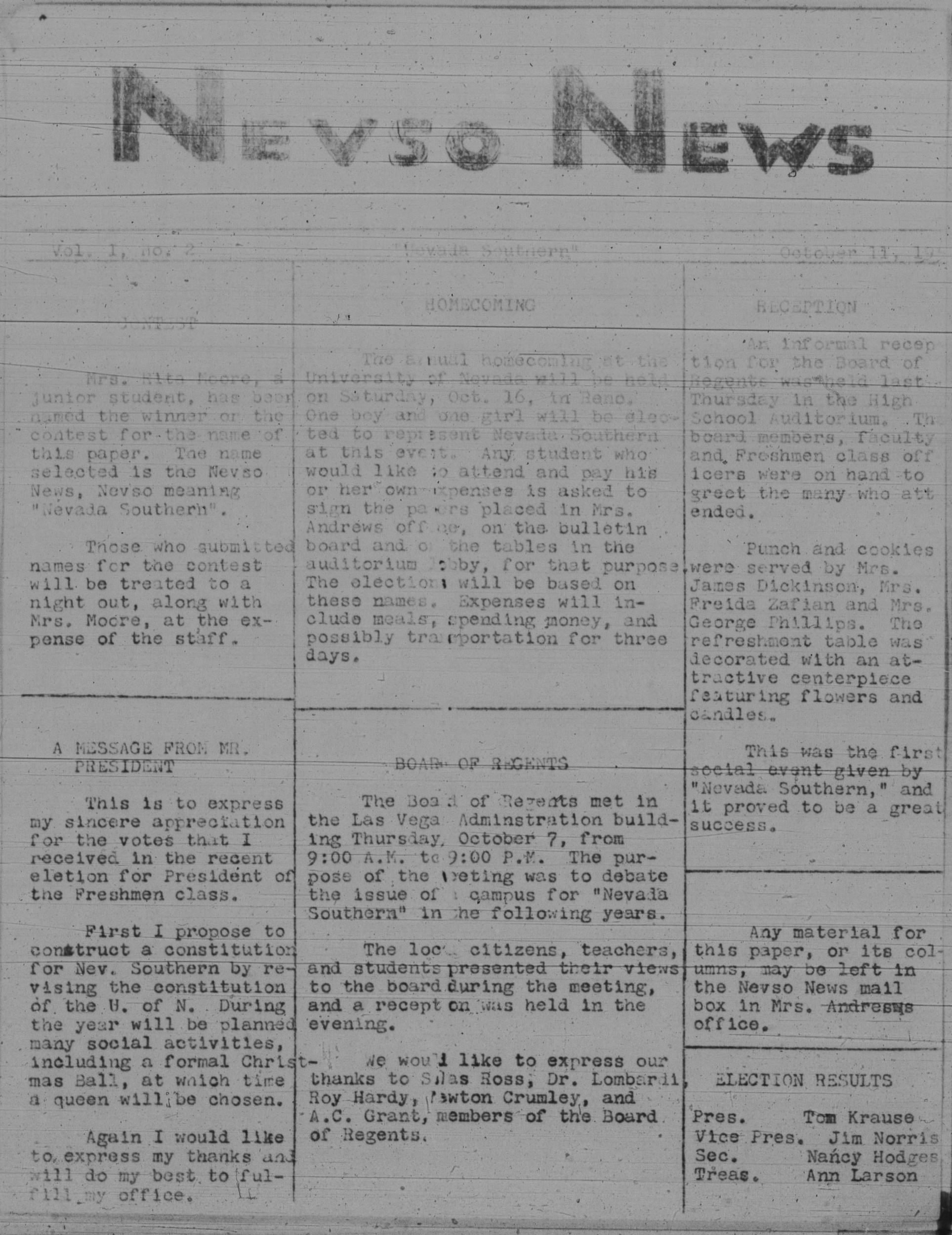Search the Special Collections and Archives Portal
Nevso News, Vol. 1, No. 2 (1954-10-11), page 2
Copyright & Fair-use Agreement
UNLV Special Collections provides copies of materials to facilitate private study, scholarship, or research. Material not in the public domain may be used according to fair use of copyrighted materials as defined by copyright law. Please cite us.
Please note that UNLV may not own the copyright to these materials and cannot provide permission to publish or distribute materials when UNLV is not the copyright holder. The user is solely responsible for determining the copyright status of materials and obtaining permission to use material from the copyright holder and for determining whether any permissions relating to any other rights are necessary for the intended use, and for obtaining all required permissions beyond that allowed by fair use.
Read more about our reproduction and use policy.
I agree.Page
Digital ID
Nevso News, Vol. 1, No. 2 (1954-10-11), page 1
Copyright & Fair-use Agreement
UNLV Special Collections provides copies of materials to facilitate private study, scholarship, or research. Material not in the public domain may be used according to fair use of copyrighted materials as defined by copyright law. Please cite us.
Please note that UNLV may not own the copyright to these materials and cannot provide permission to publish or distribute materials when UNLV is not the copyright holder. The user is solely responsible for determining the copyright status of materials and obtaining permission to use material from the copyright holder and for determining whether any permissions relating to any other rights are necessary for the intended use, and for obtaining all required permissions beyond that allowed by fair use.
Read more about our reproduction and use policy.
I agree.Page
Digital ID
The Rebel Yell
Description
The Rebel Yell and cultural identity at UNLV
The UNLV student newspaper, like the university itself, has gone through many changes not least, its
name. When the paper made its debut in 1955, what was to become UNLV was the Southern Regional
Division of the University of Nevada, in Reno, popularly known as Nevada Southern. The newspaper,
reflecting its identity with the southern part of the state as well as its ongoing opposition to the
northern-centric bias of the State Legislature in Carson City and the administration of the University of
Nevada in Reno, adopted the name “Rebel Yell” and flew a Confederate flag on its mast head. The
fledgling university took to its identity as “Rebels” which, in fact, continues as a brand for the university
and its students to this day. While administrators and students would later deny any conscious or
intended association of these historical Confederate symbols with the southern Confederacy, slavery,
and racism, they would, nonetheless cause embarrassment in the future when Black (and White)
students began to express their indignation with these symbols and demand that the university change
its image.
In 1962 the most flagrant symbol, the Confederate flag, was removed from the masthead to be replaced
by the only marginally less problematic “Beauregard” figure, a Disneyesque cartoon hound dog in a
Confederate uniform. In 1969 in the wake a national civil rights protests, Beauregard was yanked from
the masthead. In 1970 the student senate, the “Confederated Students” (which would change its name
to “Consolidated Students” in 1973) instituted a “Rebel Name-change committee” charged with coming
up with alternative names. The next year in 1971 the students voted to retain their nickname, the
Rebels, by which their sports teams had traditionally been known, but the newspaper decided to change
its name from the Rebel Yell to The Yell, but affirming on its front page “We’re Still Rebels”. In 1973
when the student senate changed its name, the students again rejected changing the Rebels nick-name.
Only in 1975 was Beauregard officially removed as the university mascot.
In 1982 artist Mike Smith created a new UNLV mascot, the “Hey Reb” trail-blazing pathfinder, in western
frontier garb, with mustachios that rendered him a look-alike for the cartoon character Yosemite Sam. In
1983 the Yell quietly resumed its old title Rebel Yell (briefly the Yellin Rebel) which persisted until 2016,
when, after months of deliberation and renewed calls to rebrand the university the Rebel Yell became
the Scarlet & Gray Free Press, adopting the school colors. According to then-Editor-in-chief Bianca Cseke
“a Confederate battle cry isn’t a great name for a newspaper.”
Essay Contributed by Peter Michel
Alternate Title
Place of Publication
Catherine Compton Scrapbook Pages
Abstract
The Catherine Compton Scrapbook Pages (1945) contain pages from Catherine Compton's scrapbook documenting the period of time she lived in Las Vegas, Nevada from April to July 1945 with her husband Ross when he attended the B-29 Flexible Gunnery School as part of his training assignments with the U.S. Army Air Corps. The materials include a postcard and dinner menu from the Hotel Last Frontier where the Comptons celebrated their first anniversary dinner.
Las Vegas LGBTQ Community Center of Southern Nevada Audiovisual Collection
Abstract
The Las Vegas LGBTQ Community Center of Southern Nevada Audiovisual Collection contains seventeen VHS tapes which contain recordings of "Beyond the Rainbow" a Gay and Lesbian Center of Southern Nevada Cable show; the LGBTQ Center of Southern Nevada 1998 and 1999 Honorariums; and news program relating to "Pride Ride 2000." "Beyond the Rainbow" was a weekly cable show sponsored by the Gay and Lesbian Community Center of Southern Nevada created not just to reach the LGBTQ+ community, but anyone interested in learning more about the community and the issues faced by its members.
Barbara Cloud Personal Papers
Abstract
The Barbara Cloud Personal Papers date from approximately 1880 to 2004 and consist of Cloud's personal research into her family history, as well as her early work as a graduate student at the University of Washington. The collection contains Cloud's thesis manuscript, published doctoral dissertation, and an award given to Cloud by Washington State Historical Society. Materials also include reproductions of family photographs, research files, copies of J. A. Slover's autobiography later published by Cloud and her mother, and Slover's original handwritten autobiography from 1907.
Frances Faye oral history interview
Abstract
Oral history interview with Frances Faye on December 30, 1974 with an unknown interviewer for the UNLV University Libraries Oral History Collection.
September Sarno oral history interview
Abstract
Oral history interview with September Sarno conducted by David Schwartz on October 06, 2007 for the Remembering Jay Sarno Oral History Project. In this interview, Sarno discusses her early life and moving to Las Vegas, Nevada at the age of five. She remembers living at her father’s hotels growing up, the lifestyle she was born into, and the final months before the passing of Jay Sarno. Lastly, Sarno talks about the impact that her father has had in Southern Nevada.
Juliana Chen oral history interview
Abstract
Oral history interview with Juliana Chen conducted by Cecilia Winchell and Stefani Evans on March 21, 2021 for Reflections: The Las Vegas Asian American and Pacific Islander Oral History Project.



